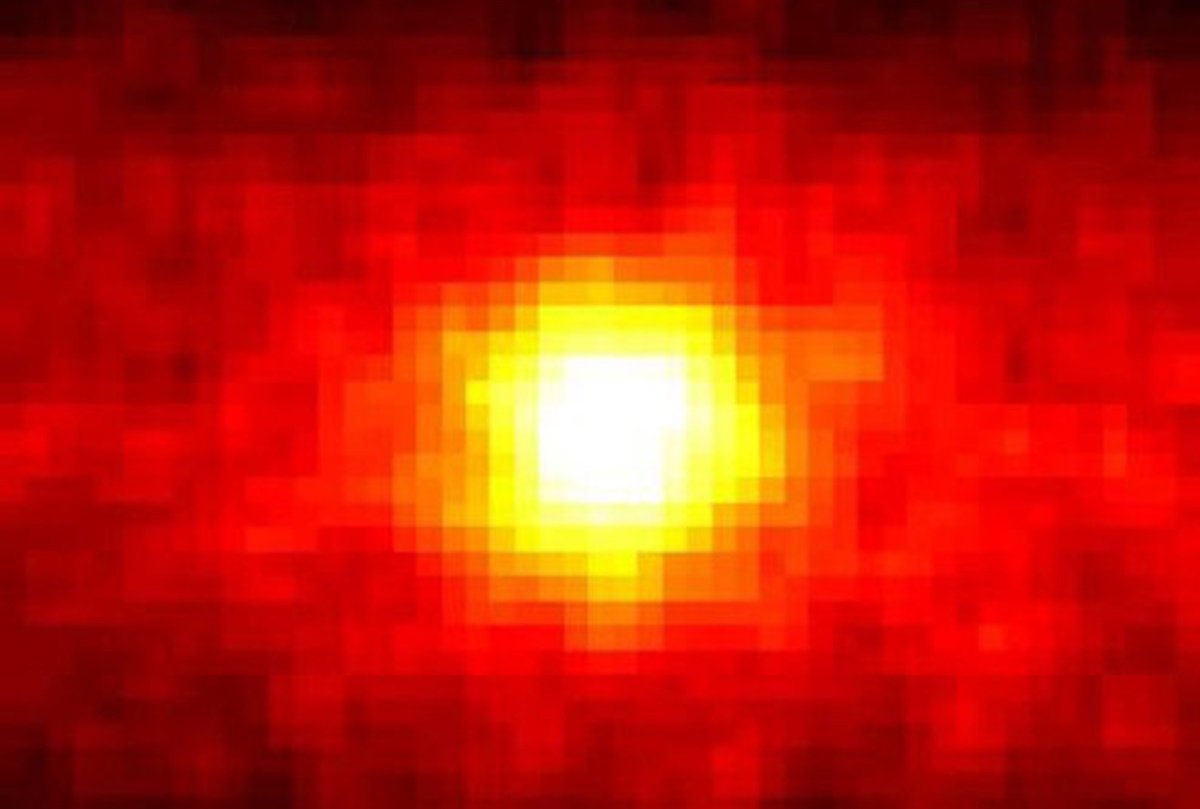Every week, TecMundo and #AstroMiniBR bring together five relevant and entertaining astronomical curiosities produced by the world’s collaborators. twitter profile It was created to spread the knowledge of this oldest science! Check out last week’s highlights below.
#1: A photo of the Sun without “seeing” the Sun!
[A foto mais legal do Sol]#FisicaThreadBR #DropsDeFisica #AstroMiniBR
.
Seems like a pretty bad picture, right? It turned out to be pulled OVER THE WORLD! To do this, we detect not light, but particles called “neutrinos” emitted in the Sun’s nuclear reactions. pic.twitter.com/wCFwESWVzw— Eduardo Sato ???? (@ea_sato) February 20, 2023
The image you see above is a recording of the Sun taken from inside the Earth, not directly! This impressive feat occurred in 1998 and was obtained from “neutrino light” recorded by the Super-Kamiokande detector in Japan. To break the record, a 503-day exposure was required by the Japanese instrument, during which neutrinos emitted by the solar core were detected in a massive 50,000-tonne pool of water located at a depth of 1 km.
Neutrinos are fundamental particles of nearly zero-mass matter that interact only with the weak nuclear forces and gravity. This allows these particles to move unhindered through ordinary solid matter at nearly the speed of light. During a rare interaction between a neutrino and an electron in water, the electron is accelerated to a speed greater than the speed of light in water, producing a pulse of light known as Cherenkov radiation. These pulses are detected by thousands of light amplifiers placed on the surface of the pool, and one of the results of this detection is this impressive image.
#2: Cosmic Carnival!
The universe celebrates Carnival with its colors too ??
this beautiful Trifid nebula. Young stars in this object can eject electrons from the gas in this region by emitting blue light, and when the electrons recombine, the gas glows in this purple/pink light.#AstroMiniBR pic.twitter.com/NKXc05gpgk
— yanna martins franco (@martins_yanna) February 19, 2023
Carnival is over, but Carnival is eternal (or nearly) in the Cosmos! Among the majestic and bright group of celestial bodies is the Trifid Nebula in the above image, which combines beauty and chaos.
Also known as M20, this nebula is relatively easy to see from Earth, with good binoculars it can be observed in the constellation Sagittarius.
The energetic star formation processes that take place intensely in the nebula create not only the colors but also the enormous turbulence. The glowing red gas is the result of high-energy starlight hitting molecular gas, primarily hydrogen, in the interstellar cloud. The dark dust filaments surrounding M20 were created in the atmospheres of cold giant stars and the debris of supernova explosions.
It takes about 50 years for the light emitted by M20’s stars to fully pass through, and the light we see today set off about 3,000 years ago.
#3: Huge VY Canis Majoris
One of the largest stars ever detected is VY Canis Majoris, about 1420 times the diameter of the Sun!
In the video we have a comparison of Earth > Sun > Eta Carinae > Betegelse (reaches Jupiter’s orbit) > VY Canis Majoris.#AstroMiniBR pic.twitter.com/kQBpoAYzTk
– Ana Carolina Owner (@astroposses) February 24, 2023
Even for astronomers professional in astronomy, it is difficult to get used to the vastness of space and the gigantic size of some celestial bodies. As for stars, it’s common for the record holder for the largest star in the galaxy to stay on the podium for only a few years until an even bigger one is discovered and replaced.
That was the case for VY Canis Majoris, a red hypergiant star in the constellation Canis Major, once thought to be the largest star ever found. Its incredibly large radius is about 1,420 solar radii, and if you’re still not convinced that it’s absurdly large, here are some more familiar numbers: Our Sun has a circumference of about 4.3 million kilometers, and Canis Majoris is about 4.3 million kilometers. .about 3 billion kilometers!
#4: M92’s jewelery box
This is M92, a globular star cluster containing about 300,000 stars and located 27,000 light-years from here.
This image shows a small portion of M92 and was one of the first scientific observations made by the James Webb Telescope.
[1/2]#AstroMiniBR pic.twitter.com/r548LnUIhs
— Patricia Cruz, PhD (@patyccruz2) February 25, 2023
27,000 light-years from Earth, in the constellation of Hercules, this beautiful globular cluster is located in M92! It is an almost spherical region of stars that orbits the core of our galaxy like a satellite and was first discovered in 1777. M92 is one of the brightest globular clusters in the Milky Way and can be seen with the naked eye under good viewing conditions.
The cluster is characterized by being very compact, containing about 330,000 stars, and as is characteristic of ancient globular clusters, the predominant chemical elements in M92 are hydrogen and helium, with only minor traces of other elements. It therefore belongs to a group called metal-poor clusters by astronomers.
#5: The future of the Sun in a single image
All stars develop due to nuclear reactions within them.
?? Like the sun, they go through a phase where they shed their outer layers and form an expanding envelope.
Like this ?? this heats the envelope and forms a planetary nebula.#AstroMiniBR pic.twitter.com/5gw3XFrP8T
— Thiago Flaulhabe (@TFlaulhabe) February 23, 2023
You’re looking at a reliable representation of what the Sun will look like a few billion years from now: a planetary nebula. This beautiful class of objects is actually one of the last stages in the evolution of low-mass stars like our Sun. These are regions of space composed primarily of cosmic gas and dust, composed of dying stars that have blasted their outer layers into interstellar space.
Despite its name, planetary nebulae have nothing to do with planets except for their observational history: The first planetary nebulae, when observed by telescopes of the past, offered a visual identity very close to that of a planet.
Source: Tec Mundo
I’m Blaine Morgan, an experienced journalist and writer with over 8 years of experience in the tech industry. My expertise lies in writing about technology news and trends, covering everything from cutting-edge gadgets to emerging software developments. I’ve written for several leading publications including Gadget Onus where I am an author.













